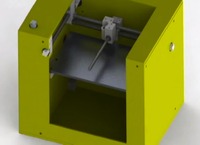 Another 3D printer startup has emerged: the Makibox A6, billed as: “The $300 Desktop 3D Printer”. The project is led by Jon Buford, who hopes to raise USD$40,000 by the end of February through the funding site Makible. Buford says: “we’ve set out to build the most affordable, compact, and easy to use 3D printer yet!” But what makes it so affordable? What makes it different from the numerous other kits? Here’s what we noticed:
Another 3D printer startup has emerged: the Makibox A6, billed as: “The $300 Desktop 3D Printer”. The project is led by Jon Buford, who hopes to raise USD$40,000 by the end of February through the funding site Makible. Buford says: “we’ve set out to build the most affordable, compact, and easy to use 3D printer yet!” But what makes it so affordable? What makes it different from the numerous other kits? Here’s what we noticed:- The design is even simpler than other 3D printer designs. For example, rather than using belts and bearings, they’re using drive screws. These design simplifications lead to much less cost
- The build envelope is actually a heated chamber! Motors and electronics are kept outside, meaning they do not need to be beefed up to handle the heat of the chamber. Again, lots of benefit at a low construction cost
- Volume priced components, as they’re hoping to build a lot of these units
- Although not part of the printer itself, MakiBox will sell ABS plastic at the incredibly low price of US$20 per Kg (about USD$9 per pound), the lowest we’ve seen. They’re also introducing a new filament size: 1mm
We love innovation and it appears that MakiBox is doing quite a bit of innovation. We’re hoping they’re successful – and they will be if you contribute to their project at the link below.


I agree additional materials is what will make platforms like this more usable. Definitely planning on figuring out how to get wax output for castings. I can see this making a semi-manual process where the printing helps save time for artists.
I agree additional materials is what will make platforms like this more usable. Definitely planning on figuring out how to get wax output for castings. I can see this making a semi-manual process where the printing helps save time for artists.
I would love to see a device like this that does wax printing, since that can be used to create investment molds for metal or resin casting.
I would love to see a device like this that does wax printing, since that can be used to create investment molds for metal or resin casting.